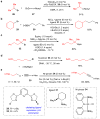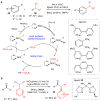Recent advances in homogeneous nickel catalysis
- PMID: 24828188
- PMCID: PMC4344729
- DOI: 10.1038/nature13274
Recent advances in homogeneous nickel catalysis
Erratum in
- Nature. 2014 Jun 5;510(7503):176
Abstract
Tremendous advances have been made in nickel catalysis over the past decade. Several key properties of nickel, such as facile oxidative addition and ready access to multiple oxidation states, have allowed the development of a broad range of innovative reactions. In recent years, these properties have been increasingly understood and used to perform transformations long considered exceptionally challenging. Here we discuss some of the most recent and significant developments in homogeneous nickel catalysis, with an emphasis on both synthetic outcome and mechanism.
Conflict of interest statement
The authors declare no competing financial interests.
Figures













References
-
- Wilke G. Contributions to organo-nickel chemistry. Angew Chem Int Ed Engl. 1988;27:185–206.
-
- Tamaru Y, editor. Modern Organonickel Chemistry. Wiley-VCH; 2005. This book provides an excellent discussion of nickel catalysis in general.
-
- Montgomery J. Nickel-catalyzed reductive cyclizations and couplings. Angew Chem Int Ed. 2004;43:3890–3908. This paper provides a comprehensive review of reductive coupling prior to 2004. - PubMed
-
- Diederich F, Stang PJ, editors. Metal-catalyzed cross-coupling reactions. Wiley-VCH; 1998.
-
- Tsou TT, Kochi JK. Mechanism of oxidative addition. Reaction of nickel(0) complexes with aromatic halides. J Am Chem Soc. 1979;101:6319–6332. This article presents an excellent investigation into the mechanism of oxidative addition of Ni(0) into aryl halides and the factors determining rate, selectivity, and solvent effects of such reactions.
Publication types
MeSH terms
Substances
Grants and funding
LinkOut - more resources
Full Text Sources
Other Literature Sources
Miscellaneous

